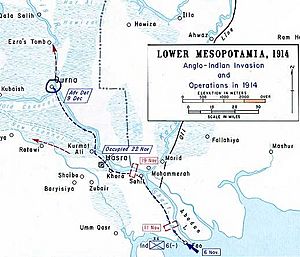Battle of Basra (1914) facts for kids
Quick facts for kids Battle of Basra (1914) |
|||||||||
|---|---|---|---|---|---|---|---|---|---|
| Part of the Mesopotamian campaign of World War I | |||||||||
 Map showing the initial British attack and capture of Basra, 1914. |
|||||||||
|
|||||||||
| Belligerents | |||||||||
| Casualties and losses | |||||||||
| 500 casualties | 1,300 casualties | ||||||||
The Battle of Basra was an important fight during World War I. It happened near the city of Basra in what is now Iraq. British and Ottoman soldiers fought here from November 11 to November 22, 1914. The British won the battle and took control of Basra.
Contents
Why the Battle Happened
Before this battle, the British had already captured a place called Fao. After that, the Ottoman army started gathering near Basra. The British wanted to protect the important oil fields in Persia (modern-day Iran). To do this, they needed to capture Basra. So, British troops began moving up the river towards the city.
The Battle Begins
On November 7, 1914, British troops started marching from Fao towards Basra. The Ottoman soldiers tried a surprise attack on the British camp on November 11. However, the British fought them off and won this first clash.
Fighting at Saihan
The Ottoman army then set up strong defenses at a place called Saihan. On November 15, the British attacked these positions. The Ottomans were defeated again, losing about 250 soldiers. The British continued their advance towards Basra.
The Main Fight at Sahil
The biggest Ottoman defense was at a place the British called Sahil. About 4,500 Ottoman soldiers were dug in there. They were hidden near palm trees and an old fort made of mud walls.
On November 19, the British launched their main attack. They used two groups of British and Indian foot soldiers, along with some cannons and cavalry (soldiers on horseback). A heavy rainstorm made it hard for them to move forward. The ground became very muddy.
The Ottoman soldiers fired their rifles and cannons, but their aim was not very good. The British and Indian troops kept pushing closer. When they got near, the British cannons finally found their target. They fired directly at the Ottoman trenches.
The old mud fort fell, and after that, the entire Ottoman army ran away. Because the ground was so muddy, the British cavalry could not chase them. The Ottomans lost around 1,000 soldiers. The British and Indian forces lost about 350.
Basra is Captured
Meanwhile, on the river, British gunboats met a small boat. People from Basra were on it. They told the British that the Ottoman army had left the city. They asked the British to come in and stop people from looting.
Several groups of soldiers quickly got onto the gunboats. On November 22, Indian soldiers from the 104th Wellesley Rifles and 117th Mahrattas entered Basra. They took control of the city without any more fighting.
What Happened Next
Taking Basra was a big step for the British. It helped them protect the valuable oil fields and oil factories in Persia. However, the British mission became unclear after this. This led them to push further up the river, which caused more fighting later on.

